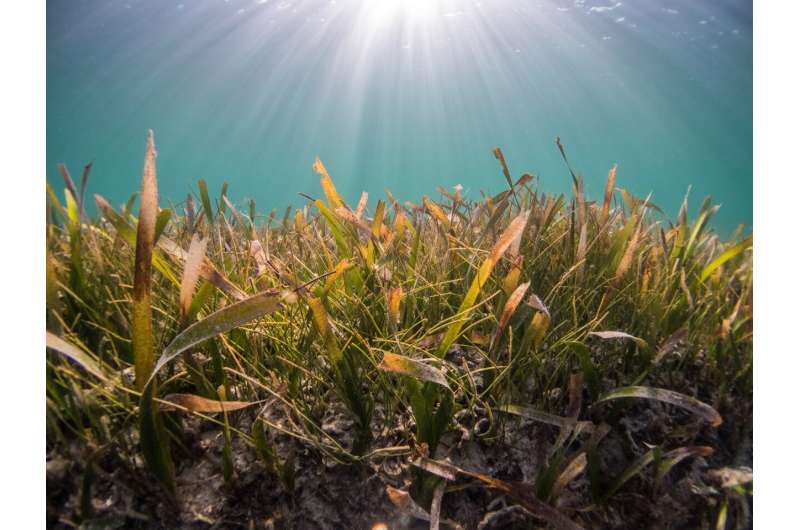Credit: Unsplash/CC0 Public Domain
Restoring coastal vegetation — so-called “blue carbon” habitats — may not be the nature-based climate solution it would be, according to a new study.
In their analysis, researchers from the University of East Anglia (UEA), France’s Center National de la Recherche Scientifique (CNRS), and the Prince Albert II of Monaco Foundation’s OACIS initiative challenge the widely held view that restoring areas such as mangroves, salt marsh and seagrass can store large amounts of carbon dioxide (CO2) from the atmosphere.
The findings of their review, published today in the journal Limits in the climateidentify seven reasons why carbon accounting for coastal ecosystems is not only extremely challenging, but also risky.
These include the high variability in carbon burial rates, vulnerability to future climate change, and fluxes of methane and nitrous oxide. The authors, who also looked at information about restoration costs, warn that additional measurements can reduce these risks, but come at a much higher cost.
However, they emphasize that blue carbon habitats still need to be protected and restored where possible, as they have benefits for climate adaptation, coastal protection, food supply and biodiversity conservation.
Lead author Dr. Phil Williamson, an honorary reader at UEA’s School of Environmental Sciences, said: “We’ve looked at the processes involved in removing carbon and there are just too many uncertainties. The expected climate benefits of restoring the blue carbon ecosystem can be achieved, yet it seems more likely that they will fall seriously short.
“If you want to remove extra carbon, you need extra habitat and the possibilities for recovery are limited. Many of these sites are built-up, for coastal settlement, tourism and port development.
“Nevertheless, we believe that every effort should be made to halt and where possible reverse the global loss of coastal vegetation. That’s because blue carbon habitats are more than carbon storage – they also provide storm protection, support biodiversity and fisheries, and improve water quality.”
The sediments under mangrove forests, tidal salt marshes and seagrass beds are rich in organic carbon, collected and stored over many hundreds of years.
Many recent studies and assessments have favorably identified the potential for these coastal blue carbon ecosystems to provide a natural climate solution in two ways: through conservation, reducing greenhouse gas emissions from the loss and degradation of such habitats; and through recovery, to increase carbon dioxide uptake and long-term storage.
This new assessment focuses on the latter and assesses the feasibility of achieving quantified and safe carbon removal (negative emissions) through coastal vegetation restoration.
More and more companies and states have pledged to offset their emissions by restoring these ecosystems through carbon credits, based on reliable knowledge of how much CO2 they will remove from the atmosphere in the future.
dr. Williamson and co-author Prof. However, Jean-Pierre Gattuso, of CNRS and the Prince Albert II of Monaco Foundation’s OACIS initiative, say the policy issue is more subtle. That is, CO2 blue carbon coastal remediation removal has questionable cost-effectiveness when considered only as a climate mitigating action, either for carbon offsetting or for inclusion in countries’ nationally determined contributions, outlining their efforts to reduce emissions and adapt to the effects of climate change under the Paris Agreement.
“If we use these ecosystems in a major way for carbon offsetting, expecting that they would remove up to, say, 100 gigatons of carbon dioxide in the 2025-2100 period, but find that they only have 10 or maybe just one gigatonne of CO2then climate tipping points could be crossed, with really serious consequences,” said Dr. Williamson.
“However, if such ecosystems are restored to protect biodiversity, and we find that they also remove some gigatons of CO.,2then that would be a bonus, assuming other resources are used for climate mitigation.
“Remediation should therefore complement – not replace – near-total emissions reductions. When projects to restore blue coastal ecosystems are primarily undertaken for the removal of carbon, they should include extensive long-term monitoring to verify that the intended climate benefits are achieved.”
Prof. dr. Gattuso said: “Many important issues related to carbon flux metering and storage remain to be resolved, affecting certification and could lead to over-crediting.
“Nevertheless, the restoration of coastal blue carbon ecosystems is highly beneficial for climate adaptation, coastal protection, food supply and biodiversity conservation. Such action can therefore be socially responsible in very many circumstances, based on the many benefits such habitats provide at the local level. ”
UNESCO Unveils Largest Carbon Repositories in Australia’s World Heritage Sites
Carbon removal using coastal blue carbon ecosystems is uncertain and unreliable, with questionable climatic cost effectiveness, Limits in the climate (2022). www.frontiersin.org/articles/1 … lim.2022.853666/full
Quote: Carbon removal using ‘blue carbon’ habitats may be ‘uncertain and unreliable’ (2022, July 28) retrieved July 28, 2022 from https://phys.org/news/2022-07-carbon-blue-habitats- uncertain-unreliable .html
This document is copyrighted. Other than fair dealing for personal study or research, nothing may be reproduced without written permission. The content is provided for informational purposes only.

